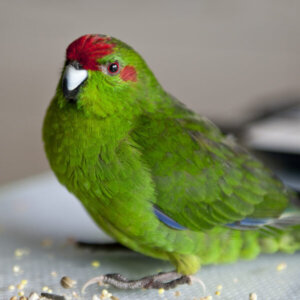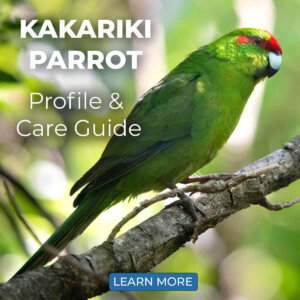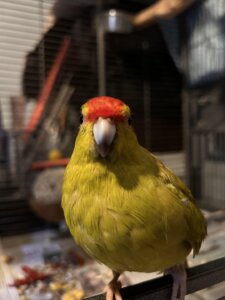Do Kakarikis Like To Be Held?: Discover the Truth
Yes, Kakarikis can enjoy being held, but it depends on the bird. Each Kakariki has its own personality.
Some love interaction, while others need more time to adjust. Kakarikis are vibrant, playful parrots known for their energy. These New Zealand natives can form strong bonds with their owners. Holding your Kakariki can be a great way to build trust and affection.
But not all Kakarikis are the same. Some may initially resist being held. It’s crucial to approach them gently and respect their comfort level. Over time, many Kakarikis grow to enjoy the closeness. Understanding your bird’s behavior is key. This guide will help you learn how to properly hold your Kakariki and ensure a positive experience for both of you.

Credit: m.facebook.com
Introduction To Kakarikis
Kakarikis are lively, playful birds known for their vibrant colors and cheerful nature. These small parrots, also known as New Zealand parakeets, make delightful pets. Their curious and social behavior can brighten any home.
Origin And Habitat
Kakarikis originate from New Zealand. They inhabit forests, scrublands, and coastal areas. Their natural environment includes dense foliage and plenty of water sources. These habitats provide ample food and shelter, which is crucial for their survival.
Physical Characteristics
Kakarikis are small, with a length of about 11 inches. They weigh around 2.5 ounces. Their feathers are mostly green, with bright red patches on the head and wings. Some species also have yellow feathers, adding to their colorful appearance.
They have strong beaks and claws, which help them forage and climb. Their tails are long and pointed, aiding in balance and flight. Their eyes are sharp and alert, reflecting their curious nature.
These birds are known for their agility and active behavior. They enjoy flying, climbing, and exploring their surroundings. This makes them fascinating pets to observe and interact with.

Credit: www.researchgate.net
Kakariki Personality Traits
Kakarikis are charming birds known for their vibrant personalities. Understanding their traits helps you bond better and ensures their well-being. Let’s delve into the unique personality traits of Kakarikis.
Social Behavior
Kakarikis are highly social birds. They thrive on interaction with their owners and other birds. These parrots enjoy being part of a flock, even if the flock is human. Regular interaction keeps them happy and prevents boredom.
Although they are social, each Kakariki has a unique comfort level with being held. Some may love the closeness, while others prefer more independence. Observing your Kakariki’s reactions helps understand their preferences.
Activity Levels
Kakarikis are incredibly active birds. They need ample space to fly and explore. These parrots are known for their playful nature and constant movement. Without enough stimulation, they can become restless.
Providing toys, perches, and regular out-of-cage time is essential. Their high energy levels make them engaging pets but also require commitment from their owners. Keeping them entertained ensures a happy and healthy life.
Bonding With Your Kakariki
Building a strong bond with your Kakariki can be a rewarding experience. These lively and intelligent birds thrive on interaction and attention. To create a deep connection, understanding their behavior is key. Let’s explore how you can bond with your Kakariki.
Establishing Trust
Trust forms the foundation of any relationship with your Kakariki. Start by spending time near their cage. Talk to them in a calm and soothing voice. Allow them to get used to your presence. Avoid sudden movements or loud noises.
Offer treats through the bars of the cage. Let them take treats from your hand. This shows that you are a source of good things. Over time, your Kakariki will start to associate you with positive experiences. Gradually, they will feel more comfortable around you.
Signs Of Affection
Kakarikis show affection in various ways. They may chirp happily when you enter the room. Some may preen your hair or clothing. This is a sign of trust and affection.
Wing flapping and head bobbing can also be positive signs. Your bird might follow you around or sit close to you. These actions indicate they enjoy your company.
Watch their body language. A relaxed Kakariki will have smooth, sleek feathers. They will be curious and playful. These are signs that your bird feels safe and bonded with you.
Handling Kakarikis
Kakarikis are lively and curious birds. They enjoy interacting with their owners. But do they like being held? Understanding safe handling techniques can make a big difference.
Safe Holding Techniques
When holding a Kakariki, use gentle and calm movements. They are small birds and can get scared easily.
Follow these steps for safe holding:
- Approach the bird slowly.
- Offer your hand for the bird to step onto.
- Support its body gently with your fingers.
- Avoid squeezing or holding too tightly.
Remember, it’s important to make the bird feel secure. A safe grip helps build trust.
Frequency Of Handling
Frequent handling helps Kakarikis get used to human touch. Regular interaction strengthens the bond between you and your bird.
Consider these tips:
- Handle your Kakariki daily for short periods.
- Ensure each session is enjoyable for the bird.
- Watch for signs of stress and give breaks as needed.
With time, your Kakariki will look forward to being held. Consistent and gentle handling ensures a happy and friendly pet.
Do Kakarikis Enjoy Being Held?
Kakarikis, also known as New Zealand parakeets, are fascinating birds. They are known for their playful and curious nature. But do they enjoy being held? This question often crosses the minds of bird owners.
Individual Preferences
Each Kakariki has its own personality. Some may love being held. Others might not enjoy it as much. Understanding your bird’s preferences is key. Observe how your Kakariki reacts to being held. This can help you determine its comfort level.
Behavioral Indicators
Watch for signs of stress or enjoyment. If your Kakariki seems relaxed, it likely enjoys being held. Signs of relaxation include soft chirping and preening. On the other hand, if it struggles or bites, it may not like being held. Respect your bird’s signals to build trust.

Credit: www.facebook.com
Alternatives To Holding
Kakarikis are lively and inquisitive birds. They might not enjoy being held all the time. But, you can still bond with them through various engaging activities. Here are some alternatives to holding your Kakariki that will keep them happy and entertained.
Interactive Play
Interactive play is a fantastic way to engage your Kakariki. Use bird-safe toys to stimulate their mind and body. Puzzle toys with hidden treats are a great choice. They encourage problem-solving and reward the bird’s effort. You can also introduce hanging toys that they can swing on. They love to climb and explore. Rotate the toys regularly to keep things fresh and exciting. This prevents boredom and keeps their interest alive.
Training And Tricks
Training your Kakariki can be both fun and rewarding. Start with simple commands like “step up” onto your finger. Use treats as positive reinforcement. Gradually, you can teach them more complex tricks. These could include fetching small objects or even playing with hoops. Training sessions should be short and frequent. This keeps your bird engaged without overwhelming them. Through training, you build a stronger bond with your Kakariki. They also get the mental stimulation they need.
Common Mistakes To Avoid
Kakarikis are vibrant and social birds. They enjoy interaction with their owners. While handling them can be enjoyable, it’s important to avoid common mistakes. These mistakes can lead to stress or discomfort for your bird. Let’s explore some of the common mistakes to avoid.
Overhandling
Overhandling is a frequent mistake. Kakarikis need time to themselves. They are curious and active birds. Constant handling can make them feel overwhelmed. This can lead to stress and anxiety. Limit handling sessions to short periods. This ensures your bird remains happy and stress-free.
Ignoring Comfort Cues
Another mistake is ignoring comfort cues. Pay attention to your Kakariki’s body language. Signs like fluffed feathers or a tense posture indicate discomfort. If your bird tries to bite, it may be feeling stressed. Respect these cues and give your bird space. This shows you care about their well-being.
| Sign | What It Means |
|---|---|
| Fluffed Feathers | The bird is relaxed or cold. |
| Tense Posture | The bird is scared or stressed. |
| Attempts to Bite | The bird feels threatened. |
By avoiding overhandling and respecting comfort cues, you can ensure your Kakariki remains happy and comfortable. This will strengthen the bond between you and your feathered friend.
Creating A Positive Environment
Creating a positive environment for your Kakariki is essential for their well-being. It can also influence whether they enjoy being held. By paying attention to their surroundings, you can make them feel more secure and happy. Here are some key areas to focus on:
Cage Setup
The cage should be spacious. Kakarikis love to move around. Provide enough room for them to stretch their wings. The cage should be well-ventilated. Ensure it is also easy to clean. Place the cage in a quiet area. Avoid high traffic zones. Too much noise can stress them. Add natural perches inside. Wooden perches are the best choice.
Enrichment Activities
Keep your Kakariki entertained. Offer various toys. Rotate them often. Include toys that encourage problem-solving. Foraging toys are a great option. They mimic natural behaviors. Interactive play is also important. Spend time with them daily. This builds trust. It helps them get used to human interaction.
Frequently Asked Questions
Do Kakarikis Enjoy Being Held?
Kakarikis may enjoy being held if they are well-socialized. They need gentle handling and trust-building.
How Can I Hold My Kakariki?
Approach your Kakariki slowly and calmly. Gently scoop them up, supporting their body.
Are Kakarikis Affectionate Birds?
Kakarikis can be affectionate if they feel safe. Building trust is essential for their affection.
How Often Should I Handle My Kakariki?
Handle your Kakariki daily to maintain their socialization. Consistent interaction helps build trust.
Conclusion
Kakarikis have unique personalities. Some enjoy being held, others prefer exploring. Respect their comfort zone. Observe their behavior closely. Build trust with gentle interactions. Gradually, they may enjoy your company more. Always approach calmly and patiently. Regular playtime strengthens your bond.
Understanding their needs ensures a happy pet. Nurture them with love and care. Happy Kakariki means a happy home.
Hello Dear, I'm Poli Kolymnia, owner of many birds (including budgies).
With a deep passion for these feathered companions, I'm here to share my expertise and extensive knowledge on birds care.
My articles cover essential topics like diet, housing, care, and health, providing practical tips to help you create a happy and thriving environment for your birds.





